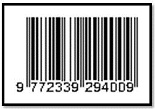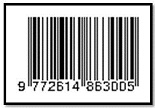“Representamen, Object and Interpretant in Humanitarian and Justice of Free Palestine Movement Taglines in Israel Allied Countries”
Abstract
This research examines the function of taglines and the semiotic structure of taglines used in the Free Palestine movement. The research examines the issue of how these taglines function as communicative tools and struggle tools, shaping meaning through semiotic mechanisms. Despite their widespread use on digital platforms, academic exploration of the communicative role and semiotic dimensions of these taglines is rare. Using a qualitative descriptive approach, this study applied semiotic theory, specifically using Charles Sanders Peirce's triadic model to analyze the selected taglines. The results of this study reveal several types of taglines, including descriptive, specific, superlative, imperative, provocative, each of which has a function as a form of support, expressing solidarity and challenging the dominant narrative. This research also identifies a semiotic structure consisting of Representamen (tagline as a sign), object (socio-political issue) and interpretant (ideological meaning constructed by the audience). This research concludes that the tagline in the Free Palestine Movement does not only convey linguistic expression but is a powerful semiotic instrument to provide resistance and mobilize public sentiment.
Keywords
Full Text:
PDFReferences
References
U. M. Zuhro Zumrotul Wahidah, “Analisis Hukum Konflik Militer Studi Kasus : Perselisihan Di Palestina Dan Israel,” Hukum Pidana Islam, vol. 3, no. 2, p. 2021, 2021, [Online]. Available: http://journal.iaimsinjai.ac.id/index.php/al-ahkam/index
Setiawan Irfan and Nainggolan Putra, “Eskalasi Konflik Palestine-Israel di Tahun 2023: Perspektif Kebijakan Luar Negeri Indonesia,” 2024.
A. Christian Max, “Pelanggaran Ham Dalam Konflik Israel dan Palestina,” vol. 6, no. 4, 2024, doi: 10.31933/unesrev.v6i4.
R. Agazi and N. Samatan, “Analysis of Charles S Peirce’s Semiotics on AQUA Advertising in Fulfilling the Aspects of Needs Version #AQUADULU,” International Journal of Management Studies and Social Science Research, vol. 05, no. 04, pp. 459–474, 2023, doi: 10.56293/ijmsssr.2022.4696.
N. M. A. B. Desi Saputri, “Pengaruh Tagline Dan Brand Ambassador Terhadap Brand Awareness,” vol. 4, Dec. 2020.
N. K. Widianti, W. Mulyawan, N. K. Alit, and I. Setianingsih, “Semiotic Analysis On Verbal And Visual Signs In Cyber Safety Poster,” Feb. 2024. [Online]. Available: https://id.pinterest.com/.
D. Chandler, “Semiotics the Basics, Second Edition,” 2002.
Laksono Panji Dimas, “Pengaruh Tagline #Dirumahaja Pada Iklan Gojek Di Instagram Terhadap Minat Untuk Menggunakan Layanan Gofood (Survei pada Followers Instagram Gojek),” 2020.
Lect. Sameerah Atshan Al-Fayyadh1, “A Social Semiotic Study of Iraw Demonstrating Slogans in October 2019,” Mar. 2025.
A. Assaiqeli, “Palestine in visual representation: a visual semiotic analysis of the Nakba,” International Journal of Arabic-English Studies, vol. 21, no. 1, pp. 99–126, 2021, doi: 10.33806/IJAES2000.21.1.6.
J. Hitchcock, “Social Media Rhetoric of the Transnational Palestinian-led Boycott, Divestment, and Sanctions Movement,” Social media and Society, vol. 2, no. 1, Jan. 2016, doi: 10.1177/2056305116634367.
F. Liaqat, M. A. Khan, and S. Summaya Qamar, “Humanity Unframed: A Socio-Semiotic Analysis Of Political Cartoon On Israel-Palestine Conflict,” 2024.
M. Rijal Fadli, “Memahami desain metode penelitian kualitatif,” vol. 21, no. 1, pp. 33–54, 2021, doi: 10.21831/hum.v21i1.
Creswell. W John, “Research Design Qualitative,Quantitative and Mixed Methods Approaches,” p. 167, 2017.
A. Syari’ah et al., “Dinamika Sosial: Jurnal Pendidikan Ilmu Pengetahuan Sosial Kekejaman Israel Terhadap Rakyat Palestina: Telaah Berita-Berita CNN Indonesia Tahun 2019-2021,” 2022. [Online]. Available: http://urj.uin-malang.ac.id/index.php/dsjpips
M. Yahya et al., “Commemorating The Naksa, Evoking The Nakba,” 2008. [Online]. Available: http://web.mit.edu/cis/www/mitejmes/
Hengky Ho, “Penerapan Hukum Humaniter Internasional dalam Konflik Bersenjata antara Palestina dan Israel,” LexEtSocietatis, vol. VII, p. 179, Feb. 2019.
B. Tweissi, “How Israel Lost the 2023 Gaza Propaganda War?,” vol. 7, no. 1, pp. 127–141, Feb. 2024, doi: 10.2307/48775010.
Ho Hengky, “Penerapan Hukum Humaniter Internasional Dalam Konflik Bersenjata Antara Palestina Dan Israel,” vol. VII, Feb. 2019.
S. Klein, “The Growing Rift between Holocaust Scholars over Israel/Palestine,” J Genocide Res, 2025, doi: 10.1080/14623528.2024.2448061.
M. B. Muntasyir, “Peran Aktif Amerika Serikat Era Joe Biden dalam Konflik Palestina dan Israel,” Jurnal PIR : Power in International Relations, vol. 7, no. 1, p. 01, Aug. 2022, doi: 10.22303/pir.7.1.2022.01-12.
S. L. Fudia, A. A. Fajrin, A. B. Y. Rizqi, and A. U. Chasanah, “Konflik Kawasan: Studi kasus Sengketa Masjidil Al Aqsa,” Journal of Integrative International Relations, vol. 7, no. 2, pp. 133–147, Nov. 2022, doi: 10.15642/jiir.2022.7.2.133-147.
J. Aditya Dewantara et al., “Pelanggaran HAM Dalam Konflik Israel dan Palestina Berdampak Terhadap Hilangnya Hak Asasi Manusia Khususnya Hak Anak di Palestina,” Jurnal Kewarganegaraan, vol. 7, no. 1, 2023.
R. Noormansyah, K. N. Nabiha, A. S. Fany, N. Ulhasanah, and A. Z. Hanifah, “From Gaza to Unity of The Ummah: Uncovering Potential of The Geopolitics of Ummah,” Jurnal Kajian Peradaban Islam, vol. 7, no. 2, pp. 178–203, Nov. 2024, doi: 10.47076/jkpis.v7i2.315.
F. Mubarok and A. R. Meidina, “The Palestinian-Israeli Conflict in the Memory of the Past the Jewish Nation: From Holocaust to Holocaust,” International Journal of Social Science and Religion (IJSSR), pp. 231–250, Jul. 2024, doi: 10.53639/ijssr.v5i2.246.
B. K. Barber, “Contrasting portraits of war: Youths’ varied experiences with political violence in Bosnia and Palestine,” in International Journal of Behavioral Development, SAGE Publications Ltd, 2008, pp. 298–309. doi: 10.1177/0165025408090972.
Y. Zai, S. Y. Hasibuan, N. Anderson Manalu, and S. Tinggi Teologi Mawar Saron Lampung, “Interpretasi Yosua 6:1-27 berdasarkan Analisis Naratif untuk Menjawab Isu Genosida dalam Teks,” Mar. 2024.
M. Mckeown, A. Roy, and H. Spandler, “‘You’ll never walk alone’: Supportive social relations in a football and mental health project,” Int J Ment Health Nurs, vol. 24, no. 4, pp. 360–369, Aug. 2015, doi: 10.1111/inm.12122.
A. Brooks and M. Griffiths, “Beyond Apartheid Israel,” Oct. 01, 2024, Elsevier Ltd. doi: 10.1016/j.polgeo.2024.103193.
J. Chaitin, S. Steinberg, and S. Steinberg, “Polarized words: discourse on the boycott of Israel, social justice and conflict resolution,” International Journal of Conflict Management, vol. 28, no. 3, pp. 270–294, 2017, doi: 10.1108/IJCMA-05-2016-0029.
DOI: https://doi.org/10.31764/leltj.v13i1.31442
Refbacks
- There are currently no refbacks.
Copyright (c) 2025 Dini Oktaviani

This work is licensed under a Creative Commons Attribution-ShareAlike 4.0 International License.
_____________________________________________________
Linguistics and ELT Journal
p-ISSN 2339-2940 | e-ISSN 2614-8633

LELTJ is licensed under a Creative Commons Attribution-ShareAlike 4.0 International License.
_____________________________________________________
LELTJ is abstracting & indexing in the following databases:
_____________________________________________________
LELTJ Editorial Office:













